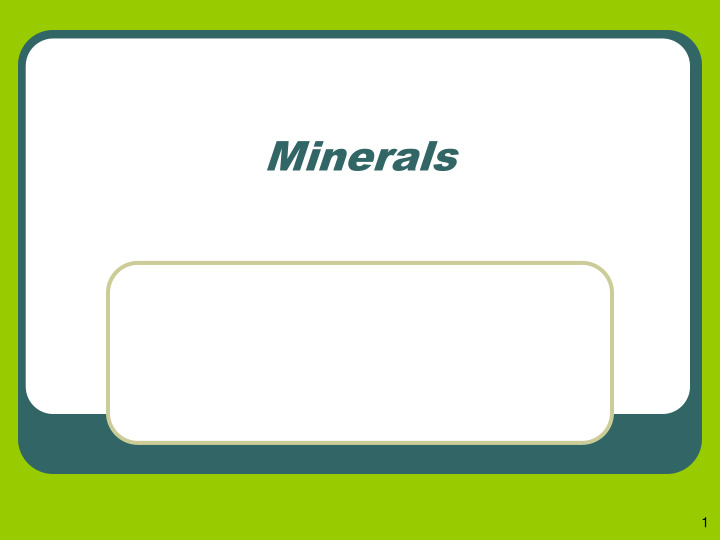



Minerals 1
Minerals Minerals are: • Naturally occurring, • Inorganic, • Solid, • Have a definite chemical composition, and • Have a definite crystal structure Mineral: Quartz, Pyrite Not Mineral: cement, steel 2
Minerals Inorganic: • Not formed from living things or the remains the remains of living things Coal is NOT a mineral because it comes from plants Amber is NOT a mineral because it comes from tree sap Pearl is NOT a mineral because it comes from oysters 3
Minerals – Chemical Composition Name of Mineral Chemical Chemical Name Elements and Formula No. of molecules 1- Sodium Halite NaCl Sodium Chloride 1- Chlorine 1 – Silicon SiO 2 Silicon Dioxide Quartz 2 – Oxygen 1- Iron Pyrite FeS 2 Iron Sulfide 2- Sulfur Fe 2 O 3 Iron Oxide 2- Iron Hematite 3- Oxygen 3- Iron Magnetite Fe 3 O 4 Iron Oxide 4- Oxygen 1- Calcium Calcite CaCO 3 Calcium Carbonate 1- Carbon 3- Oxygen 1- Carbon Graphite C Carbon Sulfur S Sulfur 1- Sulfur 4
Minerals Solids: • Have a definite volume and a definite shape • Oil is not a mineral because it is liquid Crystal Structure: • internal structure/arrangment of atoms • Atom/molecules are arranged in repeating patterns, characteristic geometry. 5
Minerals – Crystal Structure Six basic crystal systems Cubic/Isometric Tetragonal Hexagonal Galena, Halite, Pyrite Chalcopyrite Quartz, Calcite Orthorhombic Monoclinic Triclinic Olivine, Topaz Mica, Gypsum Feldspar, Turquoise 6
Minerals – Crystal Structure Cubic/Isometric Tetragonal Hexagonal Pyrite, Halite Chalcopyrite Quartz, Calcite Monoclinic Orthorhombic Triclinic 7 Gypsum Topaz Feldspar, Turquoise
Mineral Formation Minerals form • When lava or magma cools to solidification • When water evaporates dissolved minerals remain • When water is supersaturated with mineral particles; minerals will settle out of the water an deposit as a “precipitate” 8
Identifying Minerals Minerals can be identified by their physical and chemical properties. • Physical Properties: • Color • Streak • Luster • Hardness • Cleavage or Fracture • Density • Chemical Properties • Reaction to Acid Determined by chemical composition and structure 9
Physical Properties Color • Malachite-green • Sulfur-yellow • Not a reliable property; some minerals can be many different colors. • Quartz-clear, pink, purple, white, grey- brown… • Hematite-black, grey, reddish brown, dark red • Color may vary due to: • Natural coloring agents - impurities • Weathering; exposure to the environment` 10
Physical Properties Streak • The color of the mineral in its powdered form. • Determined by using a streak plate Hematite: reddish brown Quartz: White/colorless 11
Physical Properties Luster • The way a mineral shines/reflects light from its surface. Metallic: reflects light like the surface of a polished metal • Galena, Pyrite, Graphite, Magnetite… Non Metallic: reflects light in more subtle ways • Pearly-Mica, Glassy-Quartz, Dull/Earthy-Kaolinite, Waxy-Talc, Brilliant-Diamond. 12
Physical Properties Mohs Hardness Scale Hardness Common Objects • A measure of how Hardness Name of Mineral 2.5 Fingernail 1 Talc easily a mineral can 2 Gypsum be scratched. 3.5 Copper 3 Calcite • Softest mineral is 4 Fluorite Talc 4.5 Iron Nail 5 Apatite • Hardest mineral is 6 Feldspar Diamond 5.5 Glass 7 Quartz • Determined by a 8 Topaz minerals internal 6.5 Steel File 9 Corundum structure, strength of 10 Diamond bond between atoms 7 Streak Plate 13
Testing Hardness Mohs Hardness Scale Hardness Name of Mineral 1 Talc 2 Gypsum Common Objects 3 Calcite 2.5 Fingernail 4 Fluorite 3.5 Copper 5 Apatite 4.5 Iron Nail 6 Feldspar 5.5 Glass 7 Quartz 6.5 Steel File 8 Topaz 7 Streak Plate 9 Corundum 10 Diamond 14
Physical Properties Cleavage • When a mineral splits/ breaks along smooth flat surfaces • Determined by atomic structure of mineral • Cleavage is the way a mineral breaks • Crystal Shape is the way a crystal grows • Mica - One direction; sheet • Galena – Three; cubic shape Fracture • When a mineral breaks unevenly into curved or irregular pieces with a rou gh and jagged surfaces • Sulfur , bauxite, hematite , quartz 15
Physical Properties Crystal Shape and Fracture 16
Physical Properties Density or Heft • Minerals have different densities , and vary in weight given the same sample size Special Properties • Lodestone- Magnetite ; is naturally magnetic • Iceland Spar- Calcite ; produces double refraction • Pitchblend; radioactive 17
Chemical Properties Effervescence • Calcite reacts with HCl . • It forms bubbles of CO 2 (g) Oxidation – a reaction between metals and oxygen . • Iron (Fe) + oxygen = Rust • Metal is weakened by change • Copper (Cu) + oxygen = copper oxide • Creates a greenish coating; metal is not weakened 18
Uses of Minerals Ore • A mineral that contains metals and nonmetals that can be mined and removed in usable amounts; for a profit • Metals- elements that have a shiny surfaces, are able to conduct heat and electricity , and are malleable . 19
Uses of Minerals Ore - Metals Iron – Hematite/Magnetite Aluminum - Bauxite Copper - Chalcopyrite/Malachite Gold - Gold Lead - Galena Silver - Argenite 20
Uses of Minerals Nonmetals • Elements that have dull surfaces and are poor conductors of heat and electricity • Halite-NaCl- Salt • Gypsum- Drywall, chalk • Sulfur-Matches • Talc-Powder • Graphite-Pencil Lead • Calcite- Cement • Kaolinite-B ricks 21
Uses of Minerals Alloy • A mixture of two or more metals or a mixture of metals and nonmetals • Tin+ Copper = Bronze • Copper+Zinc= Brass • Iron+Chromium+ Limestone = Steel • Lead+Tin= Pewter 22
Uses of Minerals Gems • Minerals that have desirable qualities • Hardness, color , luster, clarity , durability, rarity • Precious Stones: • Diamond, Rubies, Sapphires, Emeralds • Semi-Precious Stones: • Amethyst Garnet Topaz • Gems that are not minerals • Pearls Amber 23
Recommend
More recommend